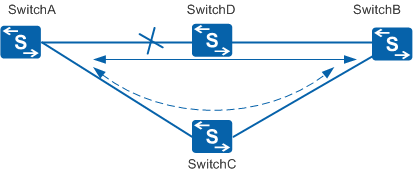BFD for IS-IS
Generally, the Intermediate System to Intermediate System (IS-IS) sends Hello packets at an interval of 10s. The holdtime of neighbors is three times the interval that Hello packets are sent. If the switch does not receive a Hello packet from its neighbor within the holddown time, the switch deletes the neighbor relationship. This means that the switch detects neighbor faults at the second level, which leads to significant packet loss on a high-speed network.
In BFD for IS-IS, BFD session establishment is triggered dynamically by IS-IS and is not configured manually. When detecting a fault, the BFD session notifies IS-IS through the RM. IS-IS will then:
- Process the neighbor Down event.
- Quickly update the link state PDU (LSP).
- Perform the partial route calculation (PRC).
This speeds up IS-IS route convergence. BFD does not replace the Hello mechanism of IS-IS, but instead works with IS-IS to quickly detect link faults and to immediately notify IS-IS of route recalculation, guiding packet forwarding. Table 1 lists the IS-IS convergence time.
BFD Session |
Link Fault Detection Mechanism |
Convergence Time |
|---|---|---|
Not bound |
Hello mechanism |
At the second level |
Bound |
BFD session in Down state |
At the millisecond level |
Application
In Figure 1, IS-IS is enabled on the devices and an association between BFD and IS-IS is enabled on SwitchA and SwitchB. When the link between SwitchA and SwitchB fails, BFD can quickly detect the fault and report the fault to IS-IS. IS-IS then disconnects the neighbors of this interface, which triggers topology calculation. IS-IS updates LSPs so that the neighbors, for example, Switch B's neighbor SwitchC, can receive the updated LSPs from SwitchB. This implements IS-IS fast convergence.
